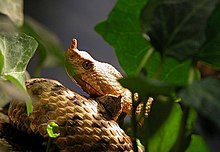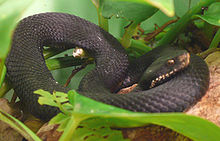Real otters
| Real otters | ||||||||||||
|---|---|---|---|---|---|---|---|---|---|---|---|---|

Adder ( Vipera berus ) |
||||||||||||
| Systematics | ||||||||||||
|
||||||||||||
| Scientific name | ||||||||||||
| Vipera | ||||||||||||
| Laurenti , 1768 |
The real otters ( Vipera ) form a genus in the subfamily real vipers (Viperinae) of the family of vipers (Viperidae). With currently 24 species, they are mainly found in Europe, North Africa and the Middle East, whereby the taxonomy is currently very much discussed. All Vipera species are ground snakes, only a few climb low bushes. The northernmost species is the adder ( Vipera berus ), which is found in Scandinavia and extends beyond the Arctic Circle . All species of this taxon are poisonous.
features
The real otters include snake species with body lengths of around 35 centimeters, such as the Atlas dwarf otters ( Vipera monticola ), up to around 1.5 meters, such as the mountain otters of Asia Minor ( Vipera xanthina ). The body is usually stocky and has a triangular head that is clearly separated from the body. The top of the head is occupied by all types of small scales. As a rule, the colors correspond to the ground on which the animals live and range from gray to reddish brown and various shades of brown to black; There are, however, no green and “brightly colored” species. The drawing often consists of dorsal pattern of spots that can merge into zigzag stripes; however, some species or subspecies are also completely black or brown or red-brown in color. A head drawing can also be present, typical patterns here are blindfolds or V-shaped spots on the back of the head.
Real otters, like all vipers, are venomous snakes. They have a corresponding poison apparatus with large poison glands behind the eyes, which are connected to the mostly large poison teeth in the front upper jaw via a poison channel .
Way of life
All species of real otters are adapted to life on the ground. They can be found on all shapes of the surface and are usually color-coded to match. Most of the species live in forest, meadow, heather and steppe areas.
In particular, the European species of the temperate to moderately warm zone can be found almost exclusively during the day, while species in warmer areas are more frequently active at dusk or at night. Due to the climatic conditions, Central to Northern European species also have periods of rest during winter, whereas species from Africa and southern Asia do not. The phases of activity, even for many European species, can, however, vary between different populations depending on the habitat type.
Most vipers feed on small mammals , which they actively chase and kill with one bite. All species of real otters are viviparous.
distribution and habitat
The representatives of the real otters are common in Europe , parts of North Africa and the Middle East. The northernmost species is the adder ( Vipera berus ), which is found in Scandinavia and extends beyond the Arctic Circle . Among them there are some species with a very large range, especially the adder. Other species are only concentrated in limited areas such as mountain ranges, such as the Taurian mountain otter ( Vipera bulgardaghica ) or the Atlas dwarf otter . Of Baran's Viper ( Vipera barani ) even a single copy of the Turkish Black Sea coast is known.
Systematics


In the recent past, several revisions were made within this genus, from which new genera such as the great vipers ( Macrophia ), the mountain otters ( Montivipera ) and the oriental otters ( Daboia ) emerged, and a number of further revisions were proposed.
|
|
|
|||||||||||||||||||||||||||
|
|
The species currently classified in the genus Vipera are:
- Vipera altaica
- European horned viper ( V. ammodytes )
- Anatolian meadow viper ( V. anatolica )
- Aspis viper ( V. aspis )
- Baran's viper ( V. barani )
- Adder ( V. berus )
- Darevski's adder ( V. darevskii )
- Western Caucasus Otter ( V. dinniki )
- Armenian meadow viper ( V. eriwanensis )
- Greek meadow viper ( Vipera graeca )
- Caucasian otter ( V. kaznakovi )
- Inverted-nosed viper ( V. latastei )
- Lotiev's Viper ( V. lotievi )
- Vipera magnifica
- Atlas pygmy otter ( V. monticola )
- Forest steppe otter ( V. nikolski )
- Vipera olguni
- Vipera orlovi
- Pontic viper ( V. pontica )
- Steppe viper ( Vipera renardi )
- North Iberian adder ( V. seoanei )
- Vipera shemakhensis
- Vipera transcaucasiana
- Meadow viper ( V. ursinii )
- Vipera walser
Fossil is known to Vipera antiqua from the early Miocene.
Snake venom
Most viper poisons are primarily haemotoxic and primarily destroy cells of the blood and the tissues surrounding them with various proteases . Hemotoxins lead to extensive tissue destruction, internal bleeding and swelling as well as necrosis and are very painful. The most effective components of the poison also include proteins that suppress blood clotting and thus together with the tissue-destroying components cause internal bleeding. Bleeding occurs under the skin, in the nasal and oral cavities and above all in the intestines and brain of the prey. In addition to these, there are also neurotoxic components in some species that act on the victim's nervous system and cause paralysis.
Individual evidence
Most of the information in this article has been taken from the sources given under literature; the following sources are also cited:
- ↑ H.-W. Herrmann, U. Joger, G. Nilson: Phylogeny and systematics of viperine snakes. III: resurrection of the genus Macroektivena (Reuss, 1927) as suggested by biochemical evidence. In: Amphibia-Reptilia . Volume 13, 1992, pp. 375-392.
- ↑ P. Lenk, S. Kalayabina, M. Wink, U. Joger: Evolutionary relationships among the true vipers (Reptilia: Viperidae) inferred from mitochondrial DNA sequences. In: Molecular Phylogenetics and Evolution . Volume 19, 2001, pp. 94-104. ( PDF 139 kB )
- ↑ Thomas Garrigues, Catherine Dauga, Elisabeth Ferquel, Valérie Choumet, Anna-Bella Failloux: Molecular phylogeny of Vipera Laurenti, 1768 and the related genera Macrophia (Reuss, 1927) and Daboia (Gray, 1842), with comments about neurotoxic Vipera aspis aspis populations. In: Molecular Phylogenetics and Evolution , 35 (1), 2005, pp. 35-47.
- ^ Vipera in The Reptile Database
- ↑ Mizsei, Edvárd, Jablonski, Daniel, Roussos, Stephanos A., Dimaki, Maria, Ioannidis, Yannis, Nilson, Göran & Nagy, Zoltán T., 2017, Nuclear markers support the mitochondrial phylogeny of Vipera ursinii - renardi complex (Squamata: Viperidae) and species status for the Greek meadow viper, Zootaxa 4227 (1), pp. 75-88
- ↑ Nilson, G. & Andrén, C. (1988) A new subspecies of the subalpine meadow viper, Vipera ursinii (Bonaparte) (Reptilia, Viperidae), from Greece. Zoologica Scripta, 17 (3), 311-314. doi : 10.1111 / j.1463-6409.1988.tb00106.x
- ↑ Samuele Ghielmi, Michele Menegon, Stuart J. Marsden, Lorenzo Laddaga and Sylvain Ursenbacher. 2016. A New Vertebrate for Europe: The Discovery of A Range-restricted Relict Viper in the western Italian Alps. Journal of Zoological Systematics and Evolutionary Research. 54 (3); 161-173. DOI: 10.1111 / jzs.12138
literature
- David Mallow, David Ludwig, Göran Nilson: True Vipers. Natural History and Toxicology of Old World Vipers. Krieger Publishing Company Malabar, Florida, 2003, ISBN 0-89464-877-2 .
- Ulrich Gruber: The snakes in Europe and around the Mediterranean . Franckh'sche Verlagsbuchhandlung, Stuttgart 1989, ISBN 3-440-05753-4 .
- Ulrich Joger, Nikolai Stümpel: Handbook of the reptiles and amphibians of Europe; Volume 3 / IIB, Snakes (Serpentes) III Viperidae. Aula-Verlag, Wiebelsheim 2005, ISBN 3-89104-617-0 .
